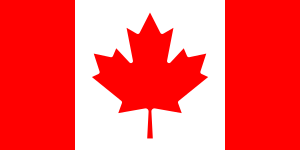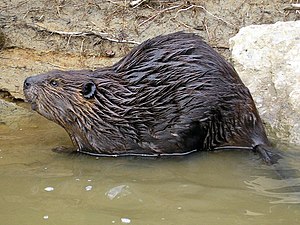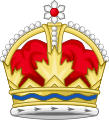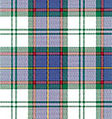Portal:Canada/Symbols
| Showcase | Content | Contributing |
National symbols of Canada
Canada's most well known symbol is the maple leaf, which was first used by French colonists in the 1700s. Since the 1850s, under British rule, the maple leaf has been used on military uniforms and, subsequently, engraved on the headstones of individuals who have served in the Canadian Armed Forces. The maple leaf is prominently depicted on the country's current and previous flags and on the country's coat of arms. The maple leaf has also been seen on the penny before circulation of that coin was stopped in 2013. Canada's official tartan, known as the "Maple leaf tartan", consists of four colours reflecting those of the maple leaf as it changes through the seasons—green in the spring, gold in the early autumn, red at the first frost, and brown after falling.
Other prominent symbols include the national motto, A Mari Usque Ad Mare (From Sea to Sea), the sports of hockey and lacrosse, the beaver, Canada goose, Canadian horse, the Royal Canadian Mounted Police, the Canadian Rockies, the Canadian parliamentary complex, the Canadarm, and, more recently, the Canadianization of totem poles and Inuksuks, With material items such as Canadian beer, maple syrup, tuques, canoes, nanaimo bars, butter tarts, and the Quebec dish of poutine being defined as uniquely Canadian. A six-pointed, hexagonal snowflake used as the insignia for the Order of Canada has come to symbolize Canada's northern heritage and diversity. The country's institutions of healthcare, military peacekeeping, the national park system, and the Charter of Rights and Freedoms are seen as uniquely Canadian by its citizens.
The Crown, displaying traditional cross pattées and fleurs-de-lis, symbolizes the Canadian monarchy and appears on the coat of arms, the governor general's flag, the coats of arms of many provinces and territories; the badges of several federal departments, the Canadian Armed Forces and Royal Military College of Canada, many regiments, police forces, on buildings, as well as some highway signs and licence plates. Also, the image of Her Late Majesty Queen Elizabeth II is on Canadian stamps, $20 bank notes, and all coins, soon to be replaced by His Majesty King Charles III, King of Canada. A poll taken in 2022 determined that 55 per cent of respondents agreed the country's monarchy helps define Canadian identity and six in 10 felt it helps to differentiate Canada from the United States. (Full article...)
| National Symbol | Image |
|---|---|
| National flag | 
|
| Royal standard | 
|
| Viceregal standard |  |
| Royal cypher | 
|
| Royal arms | 
|
| Great Seal | 
|
| National colours | Red White |
| National tree |  Maple |
| Additional national symbol |  Maple leaf |
| National animals |  Beaver |
 Canadian horse | |
| National sport |  Lacrosse (summer) |
 Ice hockey (winter) | |
| National tartan |  Maple Leaf Tartan |
| Royal Canadian Mounted Police |  Royal Canadian Mounted Police Officer |
Provincial and territorial symbols
Royal symbols
Flags
Tartans of Canada
Category Symbols of Canada
- To display all subcategories below click on the ►
Symbols selected in portal (scrolling list)
Regional tartans of Canada are represented by all Canada's provinces and territories having a regional tartan, as do many other regional divisions in Canada. Tartans were first brought to Canada by Scottish settlers; the first province to adopt one officially was Nova Scotia in 1956 (when registered at the Court of the Lord Lyon; adopted by law in 1963), and the most recent province was Ontario, in 2000. Except for the tartan of Quebec, all of the provincial and territorial tartans are officially recognized and registered in the books of the Court of the Lord Lyon, King of Arms of Scotland. (Full article...) The National Flag of Canada (French: Drapeau national du Canada), often simply referred to as the Canadian flag or, unofficially, as the maple leaf flag or l'Unifolié (French: [l‿ynifɔlje]; lit. 'the one-leafed'), consists of a red field with a white square at its centre in the ratio of 1∶2∶1, in which is featured a stylized, red, 11-pointed maple leaf charged in the centre. It is the first flag to have been adopted by both houses of Parliament and officially proclaimed by the Canadian monarch as the country's official national flag. The flag has become the predominant and most recognizable national symbol of Canada. (Full article...) The North American beaver (Castor canadensis) is one of two extant beaver species, along with the Eurasian beaver (Castor fiber). It is native to North America and has been introduced in South America (Patagonia) and Europe (primarily Finland and Karelia). The North American beaver is one of the official national wildlife of Canada symbols and is the official state mammal of Oregon and New York. North American beavers are widespread across the continental United States, Canada, southern Alaska, and some parts of northern Mexico. (Full article...) The Canada goose (Branta canadensis), sometimes called Canadian goose, is a large wild goose with a black head and neck, white cheeks, white under its chin, and a brown body. It is native to the arctic and temperate regions of North America, and it is occasionally found during migration across the Atlantic in northern Europe. It has been introduced to France, the United Kingdom, Ireland, Finland, Sweden, Denmark, New Zealand, Japan, Chile, Argentina, and the Falkland Islands. Like most geese, the Canada goose is primarily herbivorous and normally migratory; often found on or close to fresh water, the Canada goose is also common in brackish marshes, estuaries, and lagoons. (Full article...) The Canadian (French: cheval canadien) is a horse breed from Canada. It is a strong, well-muscled horse, usually dark in colour. It is generally used for riding and driving. Descended from draft and light riding horses imported to Canada in the late 1600s from France, it was later crossed with other British and American breeds. During the 18th century the Canadian horse spread throughout the northeastern US, where it contributed to the development of several horse breeds. During the peak popularity of the breed, three subtypes could be distinguished, a draft horse type, a trotting type and a pacing type. Thousands of horses were exported in the 19th century, many of whom were subsequently killed while acting as cavalry horses in the American Civil War. These exports decreased the purebred Canadian population almost to the point of extinction, prompting the formation of a studbook and the passage of a law against further export. (Full article...) The Royal Canadian Mounted Police (RCMP; French: Gendarmerie royale du Canada; GRC) is the national police service of Canada. The RCMP is an agency of the Government of Canada; it also delivers police services under contract to 11 provinces and territories, over 150 municipalities, and 600 Indigenous communities. The RCMP is commonly known as the Mounties in English (and colloquially in French as la police montée). (Full article...) The Canadian Rockies (French: Rocheuses canadiennes) or Canadian Rocky Mountains, comprising both the Alberta Rockies and the British Columbian Rockies, is the Canadian segment of the North American Rocky Mountains. It is the easternmost part of the Canadian Cordillera, which is the northern segment of the North American Cordillera, the expansive system of interconnected mountain ranges between the Interior Plains and the Pacific Coast that runs northwest–southeast from central Alaska to the Isthmus of Tehuantepec in Mexico. (Full article...) Totem poles (Haida: gyáaʼaang) are monumental carvings found in western Canada and the northwestern United States. They are a type of Northwest Coast art, consisting of poles, posts or pillars, carved with symbols or figures. They are usually made from large trees, mostly western red cedar, by First Nations and Indigenous peoples of the Pacific Northwest Coast including northern Northwest Coast Haida, Tlingit, and Tsimshian communities in Southeast Alaska and British Columbia, Kwakwaka'wakw and Nuu-chah-nulth communities in southern British Columbia, and the Coast Salish communities in Washington and British Columbia. (Full article...) An inuksuk (plural inuksuit) or inukshuk (from the Inuktitut: ᐃᓄᒃᓱᒃ, plural ᐃᓄᒃᓱᐃᑦ; alternatively inukhuk in Inuinnaqtun, iñuksuk in Iñupiaq, inussuk in Greenlandic) is a type of stone landmark or cairn built by, and for the use of, Inuit, Iñupiat, Kalaallit, Yupik, and other peoples of the Arctic region of North America. These structures are found in northern Canada, Greenland, and Alaska (United States). This combined region, north of the Arctic Circle, is dominated by the tundra biome and has areas with few natural landmarks. (Full article...) "O Canada" (French: Ô Canada) is the national anthem of Canada. The song was originally commissioned by Lieutenant Governor of Quebec Théodore Robitaille for the 1880 Saint-Jean-Baptiste Day ceremony; Calixa Lavallée composed the music, after which French-language words were written by the poet and judge Sir Adolphe-Basile Routhier. (Full article...) Lacrosse is a contact team sport played with a lacrosse stick and a lacrosse ball. It is the oldest organized sport in North America, with its origins with the indigenous people of North America as early as the 12th century. The game was extensively modified by European colonists, reducing the violence, to create its current collegiate and professional form. (Full article...) The common loon or great northern diver (Gavia immer) is a large member of the loon, or diver, family of birds. Breeding adults have a plumage that includes a broad black head and neck with a greenish, purplish, or bluish sheen, blackish or blackish-grey upperparts, and pure white underparts except some black on the undertail coverts and vent. Non-breeding adults are brownish with a dark neck and head marked with dark grey-brown. Their upperparts are dark brownish-grey with an unclear pattern of squares on the shoulders, and the underparts, lower face, chin, and throat are whitish. The sexes look alike, though males are significantly heavier than females. During the breeding season, loons live on lakes and other waterways in Canada; the northern United States (including Alaska); and southern parts of Greenland and Iceland. Small numbers breed on Svalbard and sporadically elsewhere in Arctic Eurasia. Common loons winter on both coasts of the US as far south as Mexico, and on the Atlantic coast of Europe. (Full article...) The Trans-Canada Highway (French: Route Transcanadienne; abbreviated as the TCH or T-Can) is a transcontinental federal–provincial highway system that travels through all ten provinces of Canada, from the Pacific Ocean on the west coast to the Atlantic Ocean on the east coast. The main route spans 7,476 km (4,645 mi) across the country, one of the longest routes of its type in the world. The highway system is recognizable by its distinctive white-on-green maple leaf route markers, although there are small variations in the markers in some provinces. (Full article...) Canada Day (French: Fête du Canada, [faɛ̯t dzy kanadɑ]), formerly known as Dominion Day (French: Fête du Dominion), is the national day of Canada. A federal statutory holiday, it celebrates the anniversary of Canadian Confederation which occurred on July 1, 1867, with the passing of the British North America Act, 1867, when the three separate colonies of the United Canadas, Nova Scotia, and New Brunswick were united into a single dominion within the British Empire called Canada. (Full article...) Canadarm or Canadarm1 (officially Shuttle Remote Manipulator System or SRMS, also SSRMS) is a series of robotic arms that were used on the Space Shuttle orbiters to deploy, manoeuvre, and capture payloads. After the Space Shuttle Columbia disaster, the Canadarm was always paired with the Orbiter Boom Sensor System (OBSS), which was used to inspect the exterior of the shuttle for damage to the thermal protection system. (Full article...) Parliament Hill (French: Colline du Parlement), colloquially known as The Hill, is an area of Crown land on the southern bank of the Ottawa River in downtown Ottawa, Ontario, Canada. It accommodates a suite of Gothic revival buildings whose architectural elements were chosen to evoke the history of parliamentary democracy. Parliament Hill attracts approximately three million visitors each year. The Parliamentary Protective Service is responsible for law enforcement on Parliament Hill and in the parliamentary precinct, while the National Capital Commission is responsible for maintaining the nine-hectare (22-acre) area of the grounds. (Full article...) Poutine (Quebec French: [put͡sɪn] ⓘ) is a dish of french fries and cheese curds topped with a brown gravy. It emerged in Quebec, in the late 1950s in the Centre-du-Québec region, though its exact origins are uncertain and there are several competing claims regarding its invention. For many years, it was used by some to mock Quebec society. Poutine later became celebrated as a symbol of Québécois culture and the province of Quebec. It has long been associated with Quebec cuisine, and its rise in prominence has led to its growing popularity throughout the rest of Canada. (Full article...) Maple syrup is a syrup made from the sap of maple trees. In cold climates, these trees store starch in their trunks and roots before winter; the starch is then converted to sugar that rises in the sap in late winter and early spring. Maple trees are tapped by drilling holes into their trunks and collecting the sap, which is processed by heating to evaporate much of the water, leaving the concentrated syrup. (Full article...) The coat of arms of Canada (French: Armoiries du Canada), also known as the Royal Coat of Arms of Canada (French: armoiries royales du Canada) or, formally, as the Arms of His Majesty The King in Right of Canada (French: Armoiries de Sa Majesté Le Roi du Canada), is the arms of dominion of the Canadian monarch and, thus, also the official coat of arms of Canada. In use since 1921, it is closely modelled after the royal coat of arms of the United Kingdom, with French and distinctive Canadian elements replacing or added to those derived from the British version. (Full article...) In Canadian folklore, Mussie is a creature said to live in Muskrat Lake in the Canadian province of Ontario. It is variously described, for example, as a walrus or as a three-eyed Loch Ness Monster-like creature.The legend of Mussie likely began around 1916, though legend claims that Canadian pioneer Samuel de Champlain wrote about it in the early seventeenth century. Mussie has become a part of the local culture and a fixture in the local tourism industry. (Full article...) The Canada jay (Perisoreus canadensis), also known as the gray jay, grey jay, camp robber, or whisky jack, is a passerine bird of the family Corvidae. It is found in boreal forests of North America north to the tree line, and in the Rocky Mountains subalpine zone south to New Mexico and Arizona. A fairly large songbird, the Canada jay has pale grey underparts, darker grey upperparts, and a grey-white head with a darker grey nape. It is one of three members of the genus Perisoreus, a genus more closely related to the magpie genus Cyanopica than to other birds known as jays. The Canada jay itself has nine recognized subspecies. (Full article...) Canadian heraldry is the cultural tradition and style of coats of arms and other heraldic achievements in both modern and historic Canada. It includes national, provincial, and civic arms, noble and personal arms, ecclesiastical heraldry, heraldic displays as corporate logos, and Canadian blazonry. (Full article...) A Caesar is a cocktail created and consumed primarily in Canada. It typically contains vodka, Clamato, hot sauce, and Worcestershire sauce, and is served with ice in a large, celery salt-rimmed glass, typically garnished with a stalk of celery and wedge of lime. What distinguishes it from a Bloody Mary is the inclusion of clam broth. The cocktail may also be contrasted with the Michelada, which has similar flavouring ingredients but uses beer instead of vodka. Festivals dedicated to the cocktail are held in many cities, with the largest in Calgary. The first liquor store dedicated to the Caesar opened on July 1st 2023 in Calgary AB. (Full article...) A mari usque ad mare (Latin: [aː ˈmariː ˈuːskᶣɛ ad ˈmarɛ]; French: D'un océan à l'autre, French pronunciation: [dœ̃nɔseˈã aˈloʊ̯tʁ]; English: From sea to sea) is the Canadian national motto. The phrase comes from the Latin Vulgate translation of Psalm 72:8 in the Bible: (Full article...) |























































